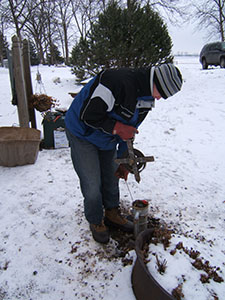Minnesota Water Science Center

Minnesota PROJECTSABOUT THE MINNESOTA
|
Project Title: Assessment of Groundwater Flow and Groundwater and Surface-Water Interaction in the Rochester Area, MN

Tom Van Heel, U.S. Geological Survey, measuring water level from a residential well in Olmsted County, MN as part of the March 2009 groundwater-level synoptic study.
Objectives: The project chief worked with geographers and a hydrologic technician to develop the hydrography and stratigraphy for the groundwater-flow model, and has complied water-use data. Elevations from the stratigraphy for the model were compared to digital elevation models of the land surface, and corrections are being made to the stratigraphy to match the digital elevation model. Once the corrections are made, an additional layer will be developed to represent glacial material above the bedrock. The current stratigraphy for the model consists of six layers representing Paleozoic bedrock in the modeling area. A hydrologic technician has compiled pumping data from large-capacity wells in the model area from the Minnesota Department of Natural Resources. Following comments from USGS and RPU hydrologists, the project chief made changes to the amendment to the original project proposal to outline the proposed monthly water-quality sampling and bromide tracer test. The bromide tracer test that was scheduled to done in August was not done due to a large amount of precipitation in August and September. The test will be done in 2011 when stream discharge values in Silver Creek at the MDNR stream gage are less that 5 cfs. On April 9, two hydrologic technicians located three potential sites along Silver Creek where bromide could be injected into the creek for the bromide injection test. Following discussions with the Minnesota Pollution Control Agency, it was determined that the bromide would be injected over a two to three day period in August when streamflow is low and municipal well pumping is high during the test. Preliminary tracer tests were conducted on April 16 and 29 in Silver Creek to determine the bromide concentrations needed to conduct the bromide tracer test in August. The August tracer test will be done to assess groundwater and surface-water interaction along the creek near the well. During both April preliminary tests, 3 liters of tracer was injected at an average rate of 0.029 L/min in Silver Creek approximately 100 feet east of County Road 22 Bridge over Silver Creek at a bromide concentration of 300 mg/L. During the April 16 test, the bromide concentrations in Silver Creek at the MDNR stream gage and at 15 Avenue were not monitored long enough to record the first arrival of the bromide tracer. During the April 29 test, the first arrival of the injected bromide occurred 1.5 and 5.2 hours after initial injection at the MDNR stream gage and at 15th Avenue, respectively. On April 28, May 18-19, June 7-8, July 7-8, August 4, and September 1, hydrologic technicians collected monthly water samples from Rochester well #27 and Silver Creek at the MDNR stream gage and at 15th Avenue. Oxygen/deuterium isotopes, nitrate, bromide, and chloride analyses were conducted on the samples to assess seasonal changes in surface-water and well-water quality as pumping rates vary during the year and to evaluate the ability of each water-quality parameter to determine surface water contributions to the well. The nitrate, bromide, and chloride analyses were done by the Minnesota Department of Health (MDH) Environmental Laboratory. During the sampling dates, monthly stream discharge measurements were made in Silver Creek at the MDNR stream gage and at 15th Ave. The specific conductance probe was calibrated installed in Silver Creek at the MDNR stream gage on April 27, but failed to work on September 1. During each sampling trip, the probe was calibrated and specific conductance and water temperature data were downloaded. The probe was sent back to the manufacturer for repair, and will be reinstalled following snowmelt in the spring of 2011. During the test, bromide will be injected over a single day and monitored for one week. Prior to the test, the Rochester well #27 will not be pumped for a day to obtain a static water level. During the test, the well will be pumped at a maximum rate to obtain the optimal conditions for surface-water capture by the well. Water samples will be collected in the Rochester well #27 and two other wells within the 10-year capture zone for the Rochester well #27 during the test. One of these other wells is screened in the Jordan aquifer south of Silver Creek and the other is screened in shallow glacial material north of Silver Creek. Stream discharge measurements will be made prior to and following the test at 8-10 locations along Silver Creek between County Road 22 and 15th Avenue. The project chief will met with RPU personnel on July 28 to update progress with the model and water-quality data collection, plan out the tracer test, and outline possible scenarios for the Groundwater Flow Management Modeling to be done using the Groundwater Management Module in MOFLOW. RPU personnel supplied the project chief with projected locations and aquifers for future municipal wells. On August 31, the project chief gave a presentation to the RPU board, outlining progress and plans for the project.
Plans for next FY11: |